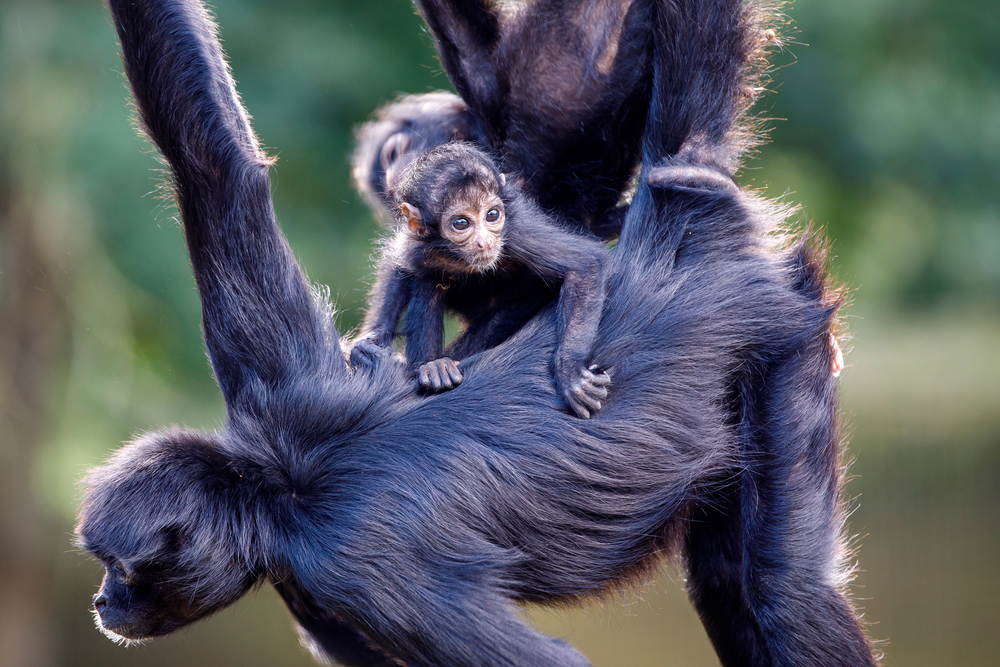In a tropical forest, a sudden crash from the treetops may herald the arrival of a troop of spider monkeys. With agile leaps and bounds, they traverse the canopy in search of food, communicating among themselves with delicate chitters and whinnies.
Seven spider monkey species, found in tropical forests from Mexico to Bolivia, showcase the wonders of primate evolution and play a crucial role in maintaining the forests they call home.
They are often seen as forest specialists that need pristine wooded areas. Yet, as human pressures threaten the continued existence of these monkeys, some species are proving more adaptable than initially thought.
Why Are They Called Spider Monkeys?
Aptly named for their unique, spider-like movement, spider monkeys navigate their environment with speed and skill.
Their lanky arms and legs work in harmony with a grasping tail, which serves as a fifth limb in the treetops. A bald patch with thick, tough skin near the end of the tail functions like a palm, enhancing their ability to hold onto branches.
(Credit: Erni/Shutterstock)
Evolution has left spider monkeys without thumbs. Their four-digit hands are thought to be better for brachiating, as pesky thumbs can get in the way when swinging from branch to branch.
This fine-tuned body plan allows them to travel quickly through the forest and cover up vast areas in their search for food.
Read More: 1,700-Year-Old Monkey Remains Give Insight to Ancient Cultures
What Do Spider Monkeys Eat?
Fueling their active lifestyle, spider monkeys rely on a diet of sugary, high-energy fruits. When enough are available, fruits can comprise over 90 percent of these monkey’s diets.
(Credit: Nick Fox/Shutterstock)
In times of fruit scarcity, spider monkeys turn to less nutritious fallback foods, like leaves and flowers.
Occasionally, they leave the trees to visit patches of exposed earth called mineral licks, where they eat soil. Though the behavior remains somewhat of a mystery to researchers, the licks could provide supplemental nutrients that are otherwise absent in the animals’ diets.
Read More: Hungry Monkeys Could Be Making Stone Tools
Unique Spider Monkey Behavior
Spider monkeys’ penchant for devouring lots of ripe, juicy fruits makes them important seed dispersers.
In tropical forests, most tree species rely on animals to transport their seeds to areas where they’re more likely to survive. To entice dispersers, trees enclose their seeds in fruits that provide a tasty reward, creating a mutually beneficial relationship between trees and the animals that spread their seeds.
Male spider monkey hunting betel nuts (Mendenhall Olga/Shutterstock)
Spider monkeys excel at the task of seed dispersal because they cover long distances in a day, which increases the chance of seeds ending up in new habitats. Their large bodies also allow them to consume copious amounts of fruit and carry numerous seeds, which spread through their droppings.
A group of Colombian Spider Monkeys sunbathing (Lauren Bilboe/Shutterstock)
Spider monkeys stay in large groups with multiple males and females, a rare sex breakdown for social species. They often split into smaller bands and regroup several times a day, a pattern called “fission-fusion” dynamics.
This unique social behavior might help them find food without too much competition, while still enjoying the safety of a large group when needed.
Read More: Female Monkeys Live Longer If They Have a Social Life
Types of Spider Monkeys
All spider monkeys share common physical characteristics and behaviors. Yet geographic isolation and evolution has led to seven distinct species, each facing unique population risks.
Red Faced Spider monkey(Credit: Ira Gallo/Shutterstock)
Vulnerable Species
-
Red-faced spider monkey (Ateles paniscus); range: Northern Brazil, French Guiana, Guyana, Suriname
Endangered Species
-
White-fronted spider monkey (Ateles belzebuth); range: Northwestern Brazil, Colombia, Ecuador, Peru, Venezuela
-
Peruvian spider monkey (Ateles chamek); range: Bolivia, Peru, Western Brazil
-
White-cheeked spider monkey (Ateles marginatus); range: Central Brazil
-
Black-headed spider monkey (Ateles fusciceps); range: Colombia, Ecuador, Panama
-
Geoffroy’s spider monkey (Ateles geoffroyi); range: Belize, Costa Rica, El Salvador, Guatemala, Honduras, Mexico, Nicaragua, Panama
Critically Endangered Species
Read More: A Primer to Our Planet of Monkeys
Threats and Predators of Spider Monkeys
For spider monkeys, life in the jungle is not without its challenges. High up in the trees, these primates face threats from birds of prey, like the formidable harpy eagle, and snakes.
(Credit: Jamie Robinson/Shutterstock)
Other predators, such as pumas and jaguars, wait for spider monkeys to climb down trees to access mineral licks – making these excursions especially risky for the monkeys.
Read More: 5 Dangerous Animals That Call The Amazon Rainforest Home
Why Are Spider Monkeys Endangered?
Today, all spider monkey species are experiencing population declines, according to the IUCN Red List. Six of the seven species are now formally listed as endangered or critically endangered, with the seventh – the red-faced spider monkey – considered “vulnerable.”
Geoffroy’s spider monkey in costa Rica (Nature’s Charm/Shutterstock)
Threats to spider monkeys depend on the species and where they are found. Hunting by humans and the illegal pet trade are two common factors.
In regions where hunters kill spider monkeys using traditional bows and arrows, populations are more likely to be stable. However, the rising use of shotguns has been linked to declines.
Capturing wild spider monkeys to trade is an age-old practice dating as far back as A.D. 200. In more recent times, the spider monkey trade has become increasingly entwined with criminal cartels, complicating legal efforts to combat it.
Read More: Indigenous Lands Could Help Threatened Primate Populations
The Deforestation of Spider Monkeys in the Rainforest
Deforestation, which drives habitat loss and fragmentation, is a more insidious threat to spider monkeys.
(Credit: Kit Korzun/Shutterstock)
Given their need for expansive territories and ample fruit supply, deforestation can limit the land’s ability to support them.
When habitat becomes fragmented, spider monkeys can become trapped in forest islands, preventing movement between groups and ultimately the flow of genes between them.
Read More: Deforestation Creates a Ripple Effect for Local Wildlife
Human Impact on Spider Monkey Habitat
Human encroachment – often behind habitat loss – brings with it its own unique suite of problems. As development expands into their habitat, spider monkeys are more likely to get hit by cars or stuck in power lines trying to cross the road.
(Credit: nikitich viktoriya/Shutterstock)
Closer proximity to humans also heightens the risk of disease transmission from people to primates and vice versa.
“I think threats are evolving, and our understanding needs to evolve with it,” says Denise Spaan, a primatologist at the University of Veracruz in Mexico. “Studies need to focus on these new threats and really understand what is happening with spider monkey populations today.”
Read More: 4 Ways Animals Adapt To Life In The Rainforest
Unexpected Spider Monkey Adaptations
Once believed to thrive solely in pristine forests, some spider monkeys have demonstrated remarkable adaptability in rapidly changing areas, according to recent observations.
“[Spider monkeys] are increasingly being spotted in cities and urban areas and neighborhoods and on top of apartment buildings and sitting next to the gas station,” says Spaan of the Geoffroy’s spider monkeys she studies in Mexico. “All places where you…would never, ever, ever expect a spider monkey to be,”
Yukatan spider monkey sitting on a roof (Saeedatun/Shutterstock)
While some might still associate spider monkeys with remote and pristine forests, Spaan emphasizes that this isn’t universally true. As these monkeys begin to appear in unexpected and often urban places, it’s essential we recognize and adapt to this new reality.
Read More: 10 Of The Freakiest Animals Found In The Tropical Rainforest














